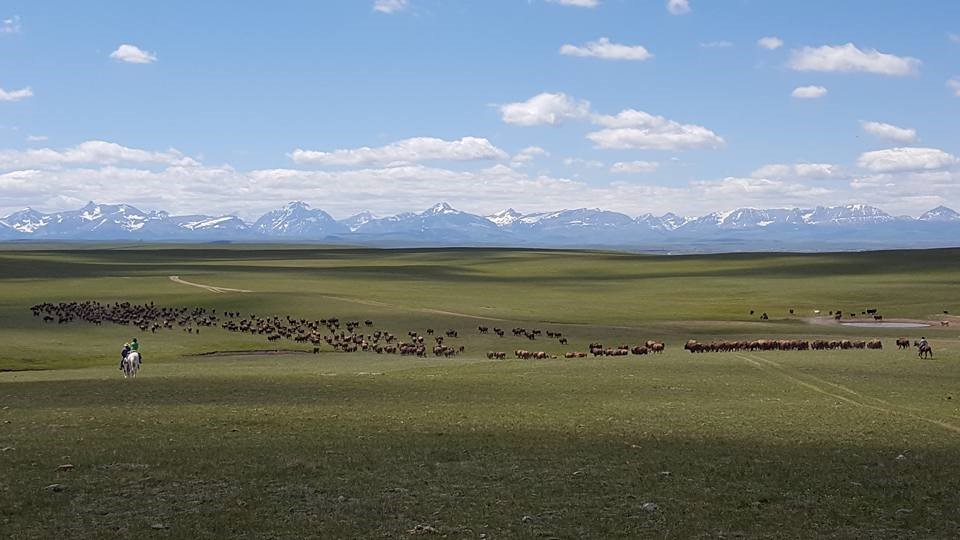Stories of Indigenous Stewardship
November 14th, 2017
S. Calling Last, MIM
 1. Iinii Initiative, Montana & Alberta
1. Iinii Initiative, Montana & Alberta
The demise of the buffalo went hand-in-hand with America’s Indian problem. In 1876, it was noted that one colonel said to his troops that they must, “kill every buffalo you can; one buffalo dead is another indian gone.” By killing the buffalo, and introducing the cow, the prairies of North America fell into the perils of ecocide culminating in the 1930s with the dust bowl. In 1492, the herds of buffalo roaming the prairies were estimated at nearly 60 million and by the 1800s there were only a few hundred left. Iinii, or buffalo in the Blackfoot language is an animal that holds ecological, cultural, and spiritual significance for many Indigenous Nations who have songs, prayers and ceremonies surrounding them. In 2010, the Blackfoot Nations of Alberta and Montana came together with government and local authorities in an effort to bring the buffalo back to the North American plains. And in 2014, for the first time in 150 years the tribes signed an inter-tribal treaty for the buffalo. In a historical moment, the signing of the “Northern Tribes Buffalo treaty” occurred in Blackfeet territory in Browning, Montana, and brought together the Blackfeet, Blood, Siksika, Piikani, Assiniboine and Gros Ventre, Assiniboine and Sioux, the Salish and Kootenai, and the Tsuu T’ina Nations. The initiative seeks to tackle many things, including land preservation, bison parks, and youth learning opportunities. To truly make America great again the buffalo must return, because the park like features and lush prairies that settlers treasured were due to the presence of the buffalo. With special chisel shaped hooves, the buffalo acted as a bio-engineering animal that tilled the surface of the prairies keeping it aerated, and lush working in tons of buffalo dung creating chest high grasses with root systems 5-15 feet deep. To learn more about this initiative you can visit their Facebook page and see our interactive map.
Learn more about this initiative in this video.
2. Bears Ears National Monument
Located in southeastern Utah this sacred place contains over 100,000 cultural sites, with some dating back to 12,000 B.C.E. The area holds significance to the nearly all Indigenous people of the southwest including the Hopi, Ute Mountain Ute, Uintah and Ouray Ute, White Mountain and Jicarilla Apache, San Juan, Kaibab, & Utah Paiute, Hualapai, Pueblos of Acoma, Cochiti, Isleta, Jemez, Laguna, Nambe, Ohkay Owingeh, Picuris, Pojoaque, Sandia, San Felipe, San Ildefonso, Santa Ana, Santa Clara, Santo Domingo, Taos, Tesuque, Ysleta Del Sur, Zia, and Zuni people. The areas sacred places have been subjected to vandalism and looting by the general public, academic and government institutions disrupting the Tribal Nations and Pueblo’s ability to practice spiritual and cultural ceremonies. In December of 2016, President Obama designated the area as a National Monument and it had seemed that the country had reached a pivotal point in reconciliation of the genocidal history between the United States and the Indigenous people. The current POTUS announced that the designation should have never happened and will be looking into a possible 90 percent reduction of the monument for fossil fuel development and very little jobs. However, it is only congress and not the POTUS that has legal authority to abolish, shrink or weaken National Monuments.
 3. Black Mesa, Arizona
3. Black Mesa, Arizona
The environmental crime of open pit strip mining at Black Mesa on the Hopi and Navajo reservation is a modern example of disposable populations, continued exploitation of indigenous people, and manifest destiny style domination of the land. Coal is a solid, brittle, carbonaceous rock that is one of the world’s most abundant fossil fuels and Black Mesa contains one of the largest deposits within the U.S. With promises of jobs, the coal mine provides approximately 1000 jobs while the mining company profits into the billions at the expense of the environment and health of the local Indigenous people. Ironically, the Navajo Generating Station creates energy to pump Colorado River water to phoenix and Tucson for the millions of metropolitan users who water lawns, fill swimming pools, water golf courses and ornamental non-native plants of the cityscape. This senseless use of water and energy is contrasted by families living less than 8 miles from the largest open pit mine, without electricity and plumbing, and hauling water from 30 miles away. The Navajo and Hopi families suffering health effects from reckless extraction and the human imposed drought from the substantial loss of groundwater and the consequential drying of springs and seeps are taking a hard cultural hit. One Hopi elder explained how Black Mesa is the palm of mother earth, with the Hopi mesas being the fingers of the hand creating the center of the universe, or the center of Hopi culture. The changing climate has impacted the ability to find native plants impacted by the changing water table and medicinal and cultural uses of the areas plants have dwindled in new generations as a result.